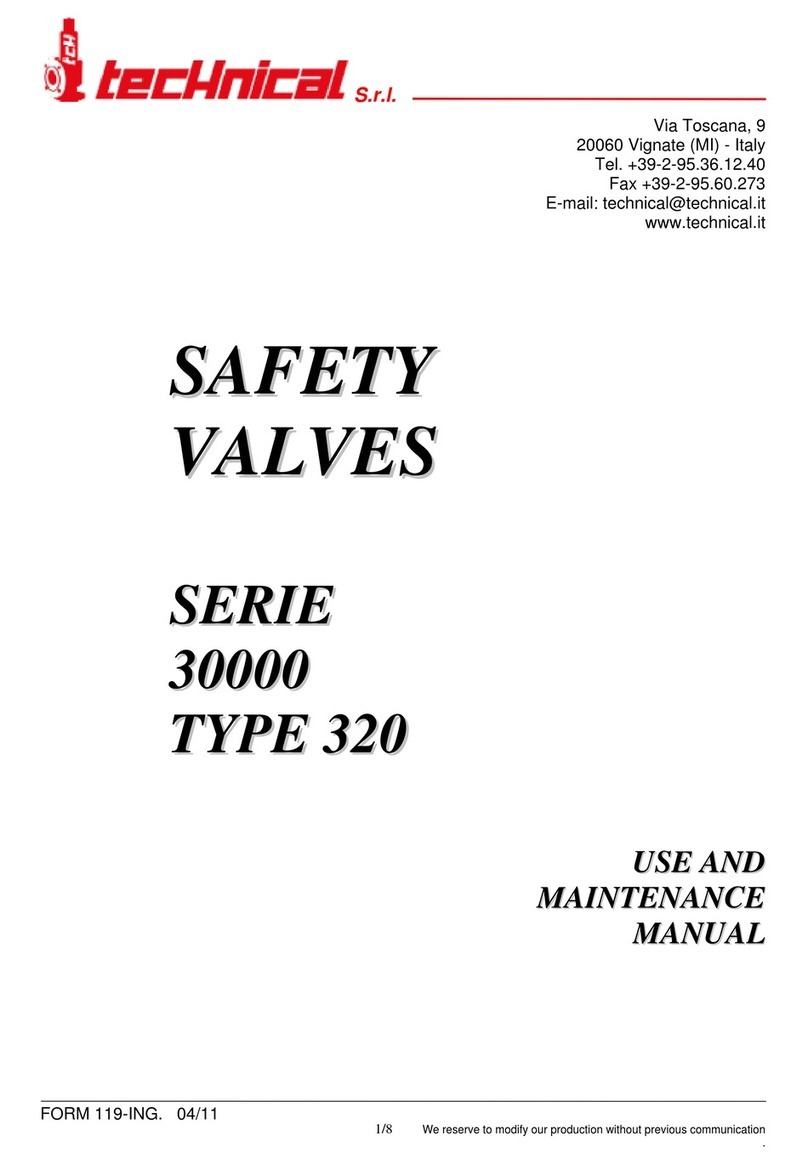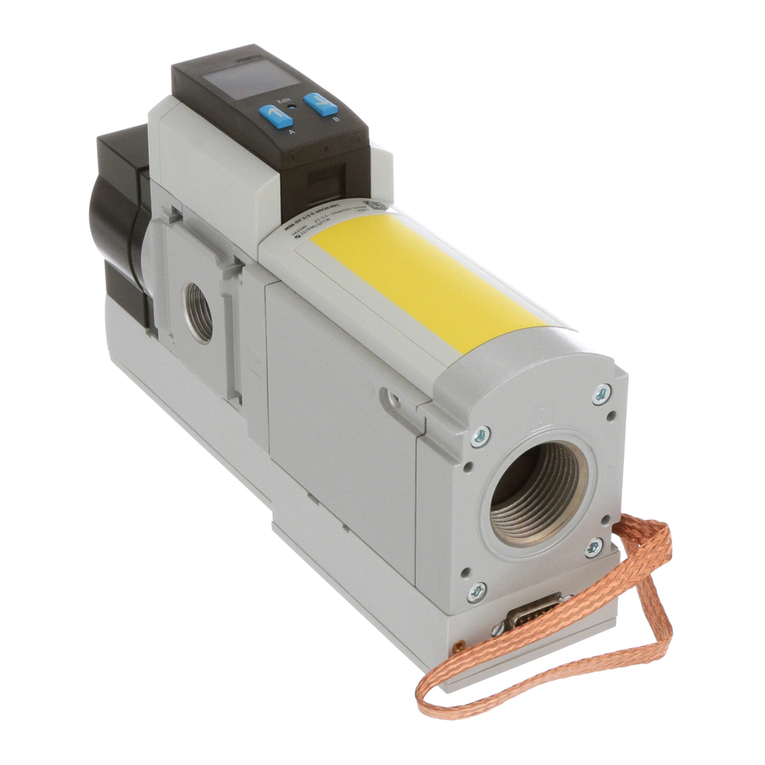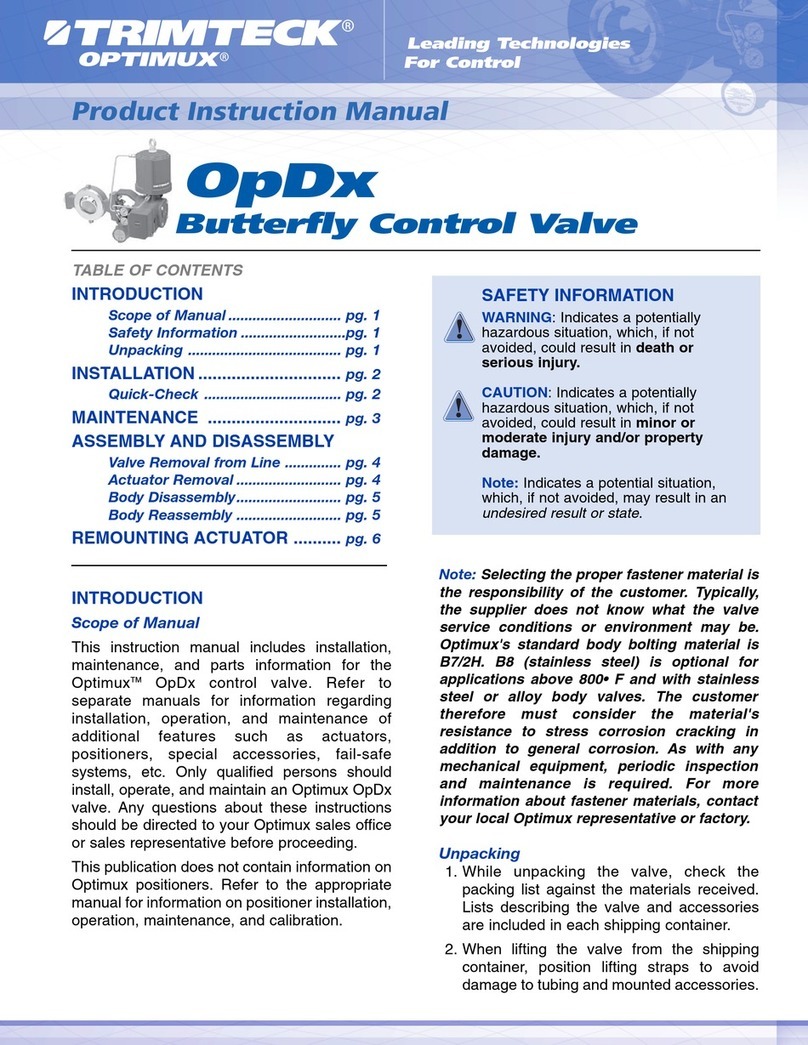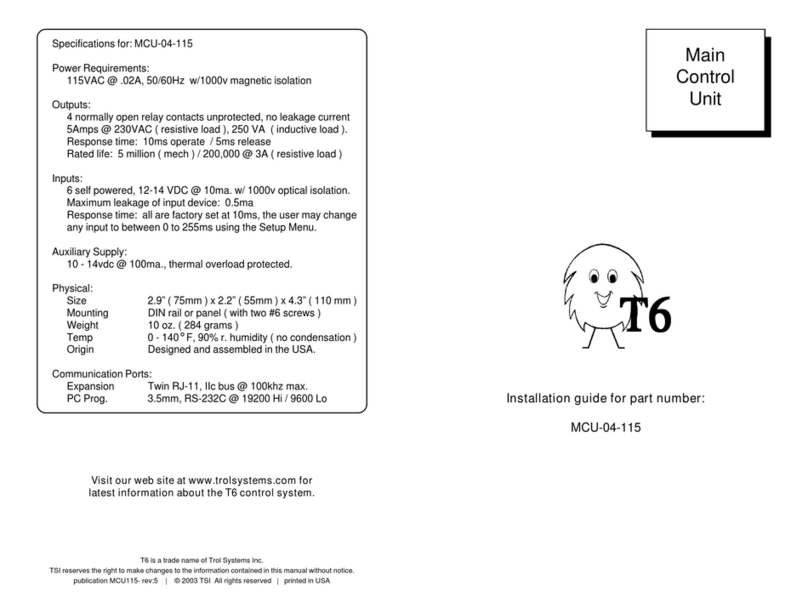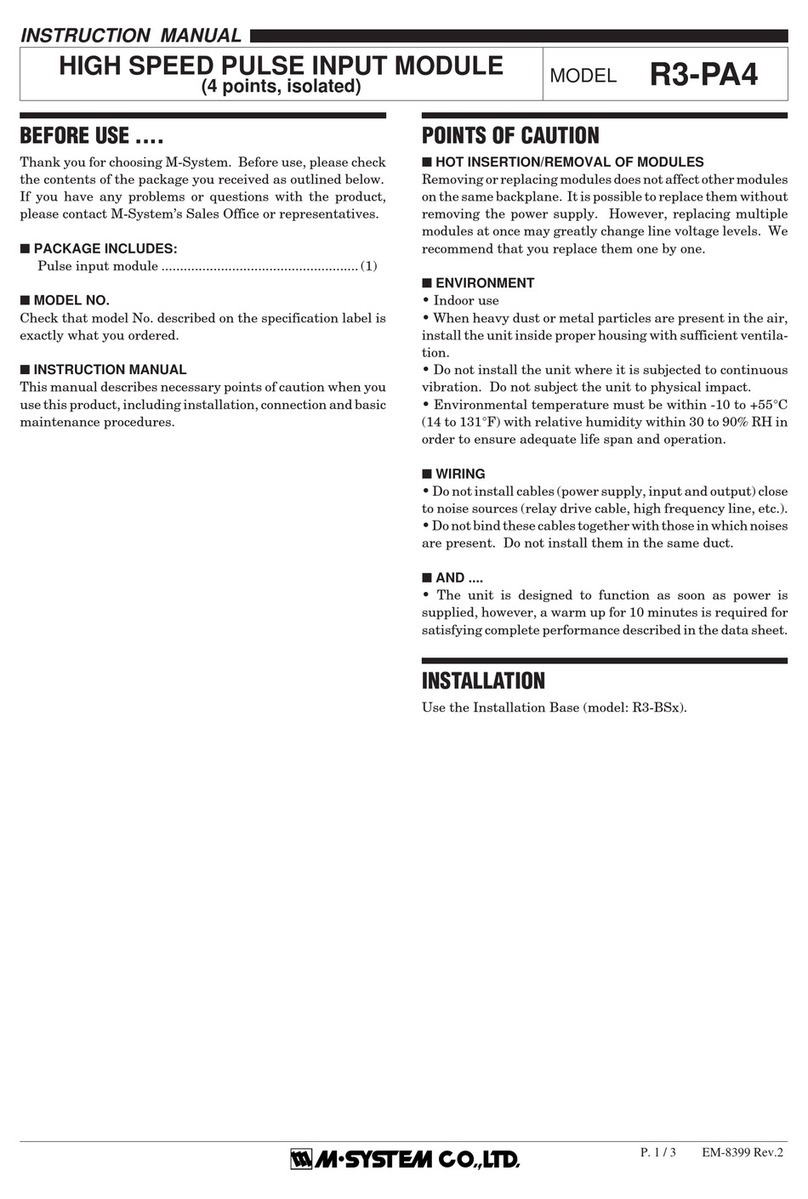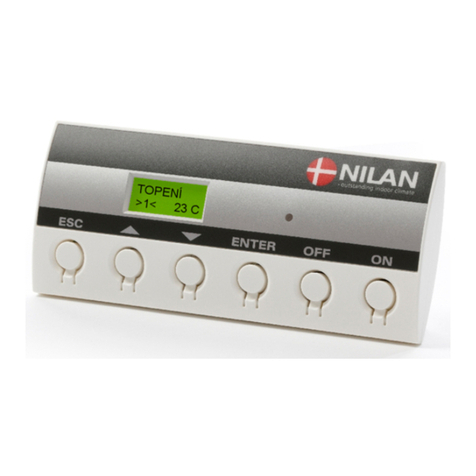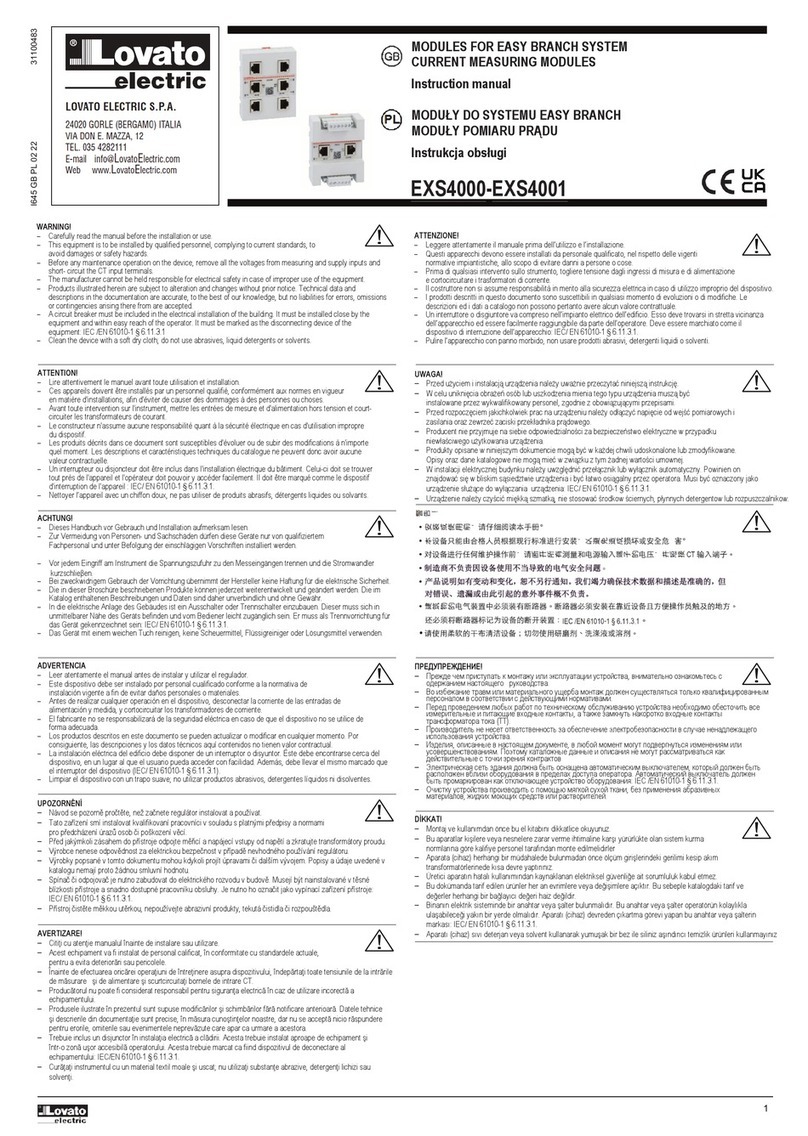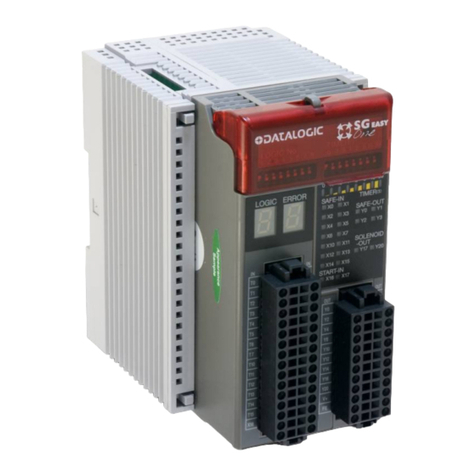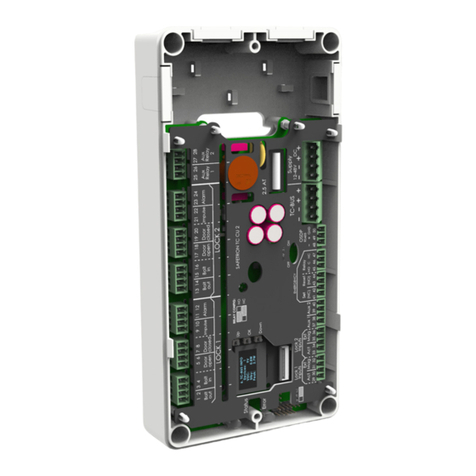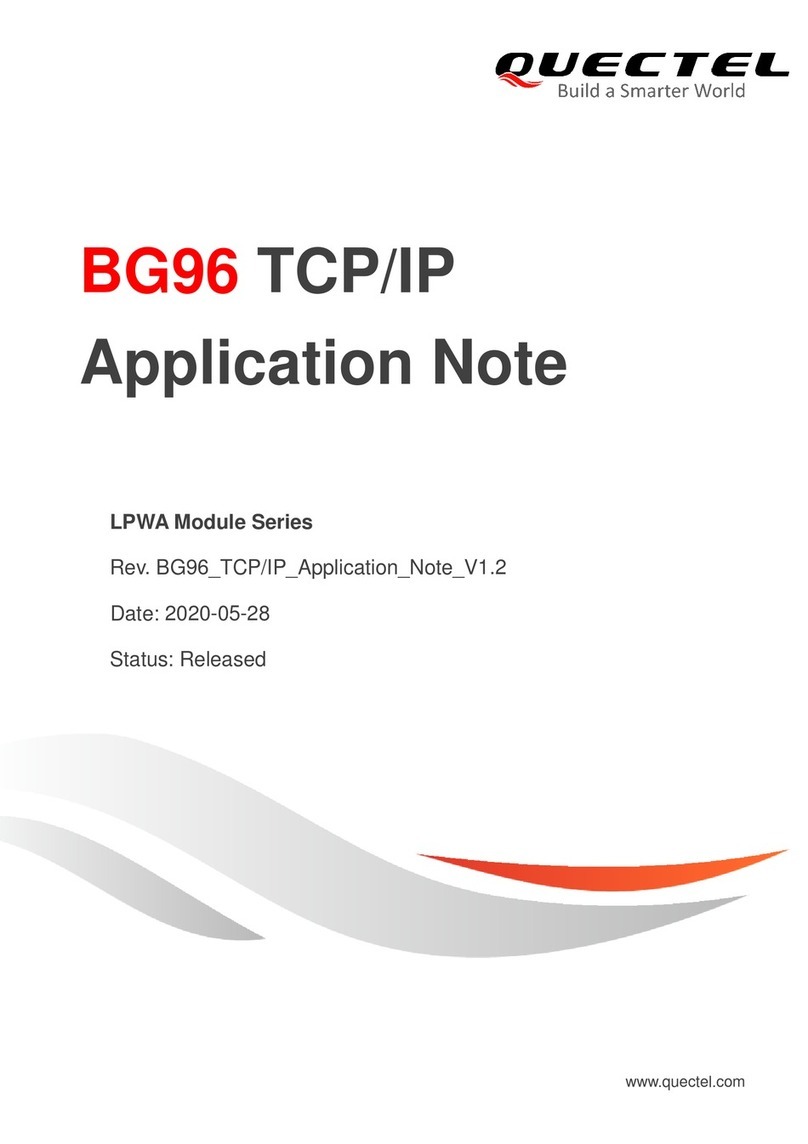Technical 30000 Series User manual

FORM 124-EN. 05/16 1/12
We reserve the right to make changes to our products without prior notice.
S.r.l.
Via Toscana, 9
20060 Vignate (MI) - Italy
Tel. +39-02-95.36.12.40
Fax +39-02-95.60.273
E-mail: sales@technical.it
www.technical.it
PILOT OPERATED
SAFETY VALVE
30000 SERIES
PROPORTIONAL
PISTON TYPE
USE AND
MAINTENANCE
MANUAL

FORM 124-EN. 05/16 2/12
We reserve the right to make changes to our products without prior notice.
VALVES FOR GASES, VAPOURS AND LIQUIDS.
Features
PED and EAC compliant;
limited overpressure;
10-20% blowdown;
spring adjustment as shown in the setting range of the pilot;
gases and vapours discharge coefficient k = 0.94;
liquids discharge coefficient k = 0.6;
connections: ANSI, UNI, DIN, AFNOR etc.
Accessories
test gag;
backflow preventer;
soft seat.

FORM 124-EN. 05/16 3/12
We reserve the right to make changes to our products without prior notice.
30000 SERIES PILOT OPERATED SAFETY VALVES
The 30000 P Series pilot operated safety valves are comparable to the conventional valves of the
same series, and retain the same orifices, discharge profiles and operational efficiency (discharge
coefficient k = 0.94). They are designed and manufactured by Technical s.r.l. in accordance with the
API 526 regulations on pilot operated valves; and are full nozzle, total lift, flat seat valves.
The body is cast, the nozzle, the disc-holder and the cylinder are cast or made from bar stock while
the bonnet and other parts subject to line pressure are made from bar stock or forged.
1. INSTALLATION
Before installing the valve in the system make sure that:
the fluid in the line is listed in the construction declaration or is compatible with the materials the
valve is made of;
the piping to the valve inlet is clean, without impurities, slag etc. and remove them if present;
the inlet and discharge piping are sized so as to minimise loss of pressure.
Installation of the valve in the system must be done by tightening the bolts in a cross pattern and
uniformly.
Once the valve has been installed in the system make sure that:
the discharge is not placed in such a way as to be dangerous for people or for the equipment;
the discharge is properly conveyed.
1.1 SET UP
Before shipment all pressure-bearing components of the safety valves are hydrostatically tested and
adjusted to the trip pressure specified by the Customer. Therefore, no on-site adjustment should be
needed.
The maximum calibration deviation is less than 3% for pressure up to 21 bar, with a minimum of 0.2
bar; it is less than 0.7 bar for pressure up to 70 bar; and less than 1% for pressure over 70 bar.
The blowdown is fixed and proportional to the set pressure.
Should it be necessary to modify the set pressure, proceed as follows:
1.1.1 Set pressure adjustment (figure 1)
To properly adjust the valve's set pressure:
remove the cap (28);
loosen the locknut (26);
turn the adjusting screw (27) clockwise to increase the set pressure;
turn the adjusting screw (27) counter-clockwise to decrease it.
The adjustment range of the spring is ± 5%; for extended ranges contact our Technical Office.
Once the setting is adjusted, tighten the locknut (26) and put the cap back in place (28) on the valve.
2. DISASSEMBLY
2.1 PILOT OPERATED VALVE WITHOUT ACCESSORIES
To disassemble the pilot operated valve, carry out the following operations, in sequence:
ATTENTION: before disassembling the valve make sure that the system on which it is
mounted is not under pressure and that no pressure remains inside the valve
itself.
Remove the valve from the system.
ATTENTION: Before disassembling the valve, slowly loosen the fittings in order to let out any
pressure that may have accumulated in it or in the pilot, and then proceed as
follows:

FORM 124-EN. 05/16 4/12
We reserve the right to make changes to our products without prior notice.

FORM 124-EN. 05/16 5/12
We reserve the right to make changes to our products without prior notice.
2.1.1 VALVE
loosen the fittings and remove the pipes (75);
unscrew the screws (62) and remove the pilot from the backflow body (65);
unscrew the screws (109) and remove the backflow preventer from the bonnet (46);
unscrew the screws (48) and remove the bonnet (46) from the valve body (37);
remove the eyebolts (58) from the bonnet (46);
remove the spring (51);
remove the guide (45) along with the disc holder (44), the disc (40) and the ball (42);
separate the disc-holder unit (44), and the gaskets (47) (49) (56) from the guide (45);
loosen the screws (41) and separate the disc (40) and the ball (42) from the disc-holder (44);
unscrew the screws (44c) and remove the flange (44b), the gaskets (43) (44a) from the disc-holder
(44);
remove the plug (37a), the screw and the gasket (52) from the valve body (37);
unscrew the nozzle (35) from the valve body (37);
remove the gasket (36), the fitting (34), the extension and the ejector (32) from the nozzle (35);
remove the gasket from the extension (32).
2.1.2 BACKFLOW PREVENTER
remove the gaskets (11), the seats (66), the gaskets (64), the ball (54) and the bushings (67);
unscrew the plug (68) and remove the gasket (69).
2.1.3 PISTON PILOT TYPES "A" AND "B"
remove the cap (28) and separate the plug (70);
loosen the locknut (26);
rotate the adjustment screw (27) counter-clockwise to fully discharge the spring (23);
remove the bonnet (25) from the lower base (31);
separate the adjusting screw (27) and the locknut (26) from the bonnet (25);
remove the spring guides (72), the spring (23), the spring guide (24) with the stem (60), the spacer
(131) and the gasket (119);
unscrew the stem (60) from the spring guide (24);
remove the lower base (31) from the pilot body (1);
extract from the pilot body (1) the group made up of cylinder (101), guide (105), piston (102), nut
(113), spindle (103), nozzle (100), nut (106), spacer (107), disc (108) and spring (110);
remove the nozzle (98) from the pilot body (1);
unscrew the nut (113) and the piston (102) from the spindle (103) and remove the seals (120)
(129);
separate the cylinder (101) from the guide (105);
separate the guide (105) from the spindle (103) and remove the gaskets (121) (128);
unscrew the nozzle (100) from the spindle (103) and remove the gasket (127);
remove the spring (110);
using milling, unscrew the nut (106) from the disc (108) and remove the gasket (112);
separate the nozzle (100) from the spacer (107);
separate the spacer (107) from the disc (108) and remove the gaskets (122) (126);
pull out the spring (104);
remove the fitting (34a) and the adapter (39) from the pilot body (1);
remove the plug (99) and the gasket (125) from the pilot body (1);
unscrew the nozzle (111) until it pulls loose from the pilot body (1) and remove the gaskets (123)
(124);
remove the filter (61), the cap (118) and the filter net (73).

FORM 124-EN. 05/16 6/12
We reserve the right to make changes to our products without prior notice.
TYPE "A"- PROPORTIONAL PILOT 4.51 - 18.7 bar

FORM 124-EN. 05/16 7/12
We reserve the right to make changes to our products without prior notice.
TYPE "B"- PROPORTIONAL PILOT 18.71 - 95 bar

FORM 124-EN. 05/16 8/12
We reserve the right to make changes to our products without prior notice.
2.1.4 PISTON PILOT TYPE "C"
remove the cap (28);
loosen the locknut (26);
rotate the adjustment screw (27) counter-clockwise to fully discharge the spring (23);
remove the bonnet (25) from the body (1);
separate the adjusting screw (27) and the locknut (26) from the bonnet (25);
remove the spring guide (72), the spring (23), the spring guide (24) with the stem (60);
separate the stem (60) from the spring guide (24);
unscrew the nut (113) from the spindle (21);
remove the spacer (114), the piston (115), the gaskets (116) (117), the bushing (85) and the gasket (117);
unscrew the connection (96) from the pilot body (1) and remove the gasket (93) and the net (73);
remove the gasket (92), the seat (91), the gasket (94) and the group made up of shutter (97), spacer (95),
nut (86), seat (90), spindle (21) and spring (84);
unscrew the spindle (21) from the seat (90) and remove the spring (84) and the gasket (88);
using milling unscrew the nut (86) from the shutter (97) and remove the gasket (87), the seat (90), the spacer
(95) and the seals (89) (87);
remove the plug (118) and the filter (61).
3. ASSEMBLY
3.1 VALVE WITHOUT ACCESSORIES
For assembly, carry out the same operations of paragraph 2.1), but in reverse order.
ATTENTION: mount the gaskets on the components in advance and lubricate them with a
silicone lubricant.
4. MAINTENANCE
The safety valve requires simple but careful maintenance (SEE MAINTENANCE PLAN) and if necessary,
perform the operations listed in paragraph 2) for disassembly, and 3) for assembly. The valve's set pressure
should be adjusted using a fluid that has the same state of the fluid to be used in operation.
If the gasket seat is damaged, it must be lapped again by specialized personnel.
Should problems arise in the valve, check the TROUBLESHOOTING TABLE for suggestions on how to solve
the problem.
If the problem is not addressed in the table, contact our Service Department.
WARNING
The pilot operated safety valves should not be subject to shock or stress that could adversely affect
their operation.
High loads on the pilot spring can damage the valve.
The safety valves must be used solely and exclusively for the fluid stated on the construction
declaration or others compatible with the materials the valve is made of.
According to Italian regulations. the safety valve must be overhauled within two years from
installation if used for hazardous fluids (Group 1) and within three years if used for other fluids
(Group 2) independently from the number of operations performed by the valve; if specific local laws
exist, comply with them.
If no regulations exist, follow the guidance given in ORDINARY MAINTENANCE PLAN table.

FORM 124-EN. 05/16 9/12
We reserve the right to make changes to our products without prior notice.
TYPE "C"- PROPORTIONAL PILOT 95.1 - 413 bar

FORM 124-EN. 05/16 10/12
We reserve the right to make changes to our products without prior notice.
ORDINARY MAINTENANCE PLAN
While in the system, inspect the tightness of the seat and
of the disc
Every valve opening
or
every 6-months of operation.
Check tightness towards the outside of the system for counter-
pressure.
Every 30 days.
Check tightness towards the outside of the pilot, the pipes, the
manifolds and the accessories.
Every 6 months.
Check the system’s paint condition.
Every 6 months.
Ordinary maintenance of the valve installed in the system, including
the tightness check and the visual inspection of moving components.
Every 12-months of operation.
General maintenance of the valve, removed from the system and
including disassembly, inspection of the gasket seat and of the disc,
and if required, lapping the seat and the disc, replacing the gaskets,
repainting the valve and bench testing.
Every time the seats are damaged during opening
or
every 24-months of operation (Group 1)
every 36-months of operation (Group 2)
TROUBLESHOOTING TABLE
PROBLEM
PROBABLE CAUSE
CORRECTIVE ACTION
Fluid leakage on the line
Seat wear and tear
Replace or overhaul nozzle
Disc wear and tear
Replace or overhaul disc
Damaged seat and disc
Overhaul nozzle and disc
Foreign matter between seat and disc
Clean and overhaul nozzle and disc
Use with a fluid different from the one stated in the
purchase order
Overhaul nozzle and disc
Leakage of fluid on the line
or of external back pressure
Damaged valve gaskets
Replace gaskets
Valve body-bonnet damage
Overhaul or replace valve
Fittings loosening
Inspect and tighten fittings
Opening at a pressure
different from valve setting
Leak in pilot circuit
Inspect and fix pilot circuit
Pilot spring failure
Replace spring and check compatibility of spring
material with the fluid
Pilot cap slipped backwards
Recalibrate the pilot and tighten the locknut
Prolonged series of quick
opening and closing of the
valve
Strong pressure loss in the inlet piping
Check the inlet piping length
Pulsating discharge flow
Check system calibration
Oversized valve
Replace the valve with one that is properly sized

FORM 124-EN. 05/16 11/12
We reserve the right to make changes to our products without prior notice.
ITEM DESCRIPTION ITEM DESCRIPTION
1
11
21
23
24
25
26
27
28
31
32
34
34a
35
36
37
37a
38
39
40
41
42
43
44
44a
44b
44c
45
46
47
48
49
51
52
53
54
56
58
59
60
61
62
64
65
66
67
68
69
70
PILOT BODY
GASKET
SPINDLE
SPRING
SPRING GUIDE
BONNET
LOCKNUT
ADJUSTING SCREW
CAP
LOWER BASE
EJECTOR
EXTENSION
GASKET
ELBOW
ELBOW
NOZZLE
GASKET
VALVE BODY
PLUG
SCREW
ADAPTER
DISC
SCREW
BALL
GASKET
DISC-HOLDER
GASKET
FLANGE
SCREW
GUIDE
BONNET
GASKET
SCREW
GASKET
SPRING
SCREW
GASKET
PIPE
BALL
GASKET
EYEBOLT
PILOT
STEM
FILTER
SCREW
GASKET
BACKFLOW BODY
SEAT
BUSHING
PLUG
GASKET
PLUG
72
73
84
85
86
87
88
89
90
91
92
93
94
95
96
97
98
99
100
101
102
103
104
105
106
107
108
109
110
111
112
113
114
115
116
117
118
119
120
121
122
123
124
125
126
127
128
129
130
131
132
SPRING GUIDE
FILTER
SPRING
BUSHING
NUT
GASKET
GASKET
GASKET
SEAT
SEAT
GASKET
GASKET
GASKET
SPACER
CONNECTION
SHUTTER
NOZZLE
PLUG
NOZZLE
CYLINDER
PISTON
SPINDLE
SPRING
GUIDE
NUT
SPACER
DISC
SCREW
SPRING
NOZZLE
GASKET
NUT
SPACER
PISTON
GASKET
GASKET
PLUG
GASKET
GASKET
GASKET
GASKET
GASKET
GASKET
GASKET
GASKET
GASKET
GASKET
GASKET
GASKET
SPACER
SCREW

FORM 124-EN. 05/16 12/12
We reserve the right to make changes to our products without prior notice.
S.r.l.
20060 Vignate (MI) - Italy
Table of contents
Other Technical Control Unit manuals
Popular Control Unit manuals by other brands
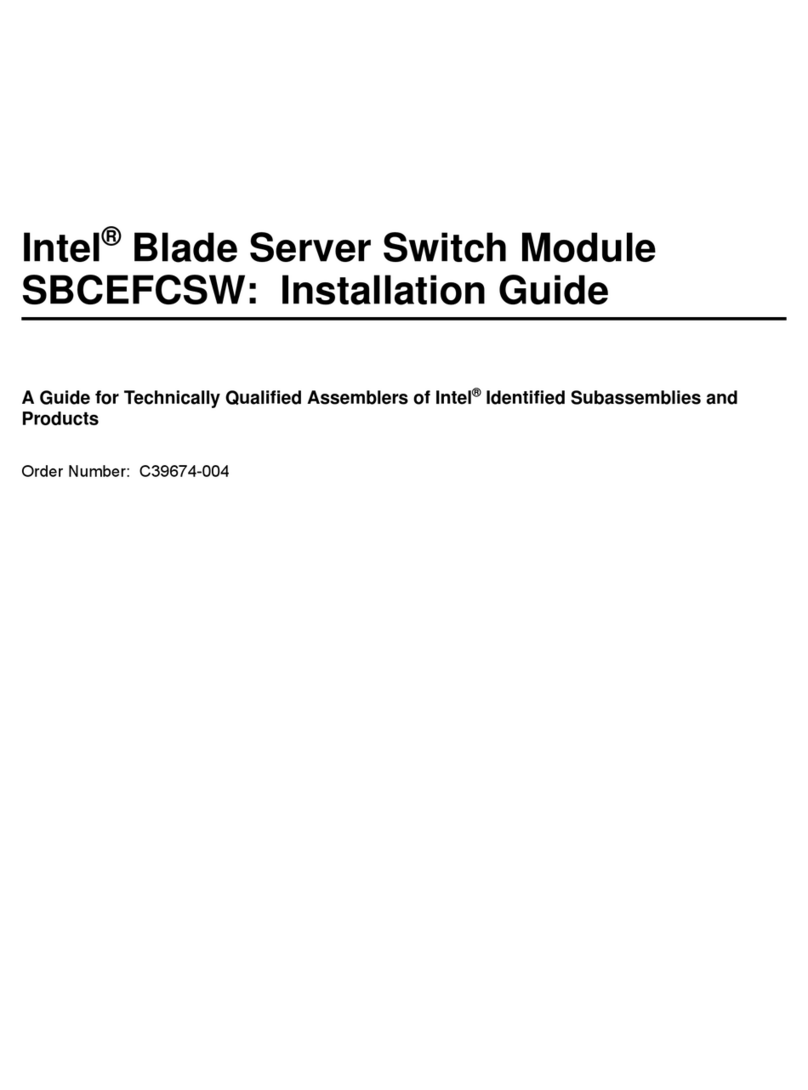
Intel
Intel SBCEFCSW installation guide
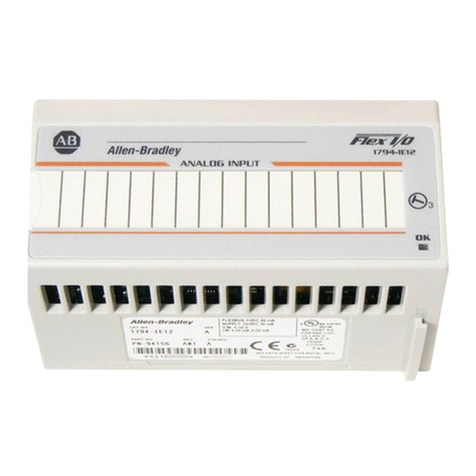
Rockwell Automation
Rockwell Automation Allen-Bradley 794-IRT8 user manual
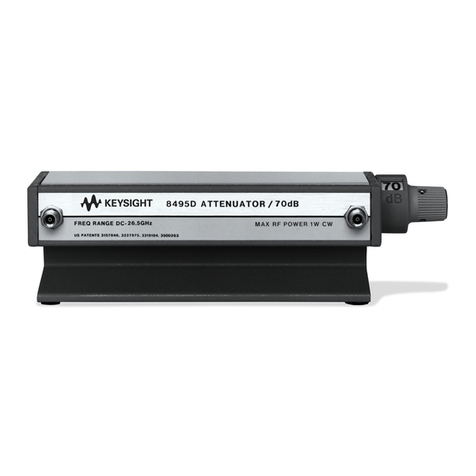
Agilent Technologies
Agilent Technologies 8495D Operating and service manual

PMK
PMK ATT10BNCS instruction manual

Aventics
Aventics RV1 operating instructions

Siemens
Siemens SINUMERIK 840Di Function manual
